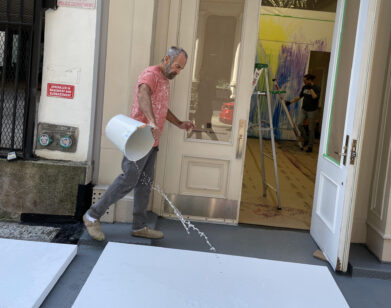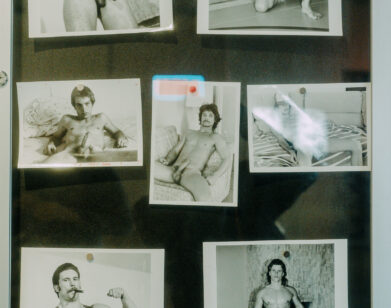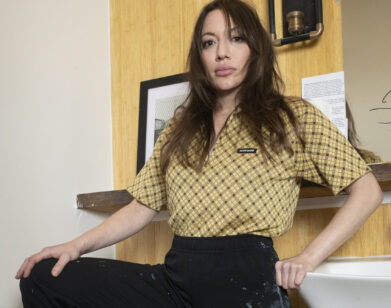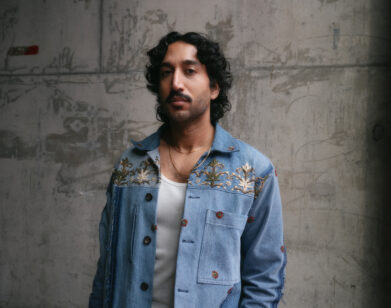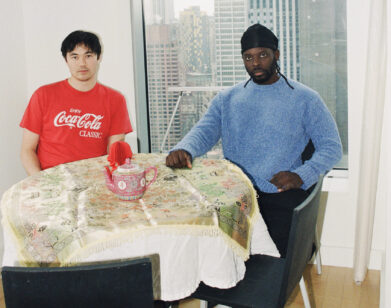Peggy Guggenheim
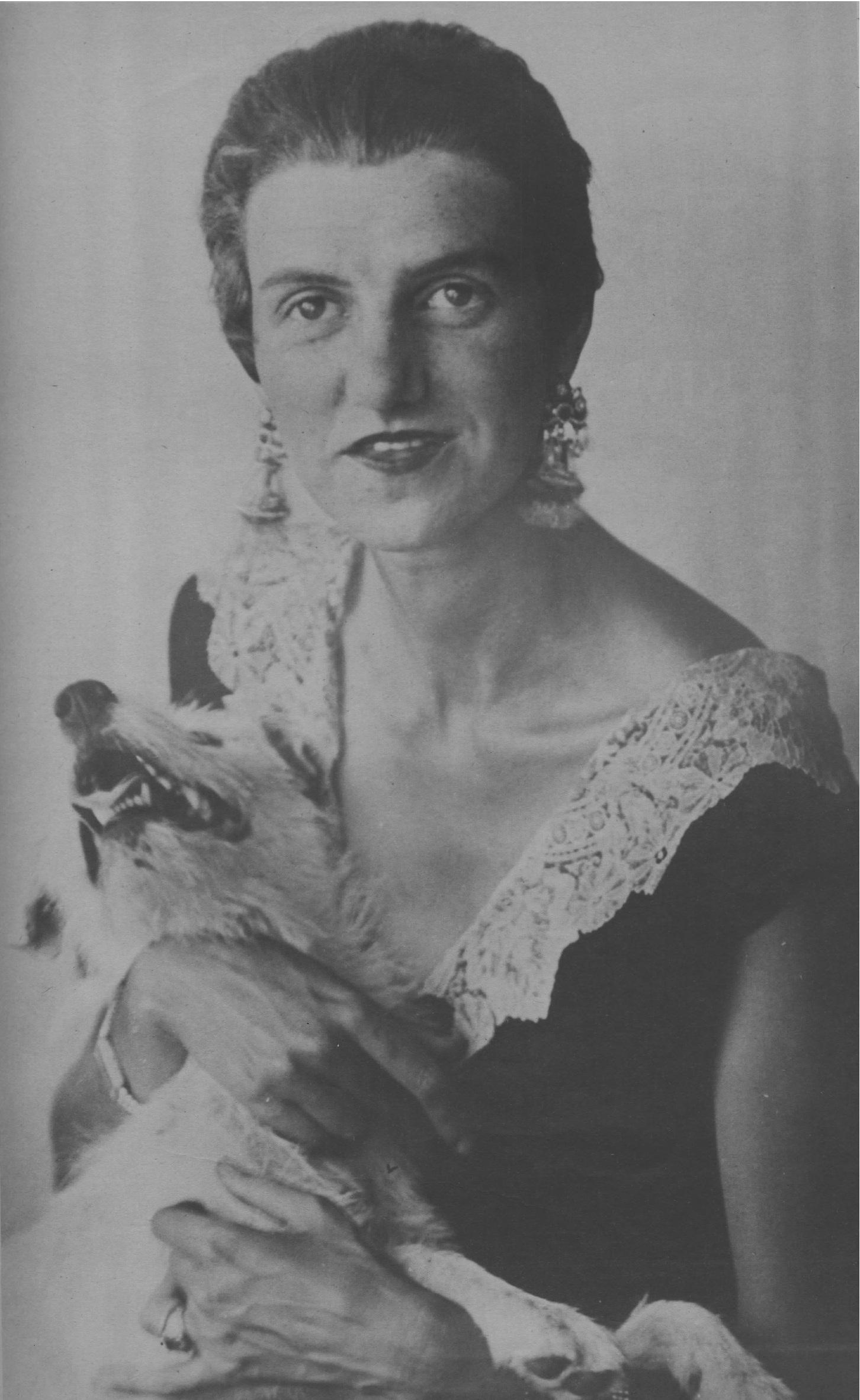
Peggy Guggenheim is one of the most amazing, amusing and courageous figures in Modern Art. Much married, with an impressive string of lovers, she began collecting surrealist works in 1938 and by the time she opened her unusual gallery, Art of This Century, on 57th street in 1941, she had amassed one of the most important contemporary collections in the western world. Apart from collecting, she “discovered” and promoted American artists in the Forties such as Robert Motherwell, Jackson Pollock, Mark Rothko, and other abstract expressionists who changed the history of modern art. Miss Guggenheim now lives in Venice in the Palazzo Veneir dei Leoni where her magnificent collection of art is opened to the public this summer. She recently gave it to the Guggenheim museum who will guard it intact after her death.
Her book of memoirs, Out of this Century, subtitled “Confessions of an Art Addict” (Universe, New York, $17.50,) appears this month. Interview asked Mario Amaya, ex-director of the Chrysler Museum and American editor of Connoisseur, to speak to Miss Guggenheim by telephone: New York to Venice.
MARIO AMAYA: Peggy dear, it’s Mario. I’m calling from New York.
PEGGY GUGGENHEIM: Oh, hello!
AMAYA: I did enjoy the book so much. I finished reading it just yesterday.
GUGGENHEIM: Oh, that’s wonderful.
AMAYA: I thought it was excellent. I could hear your voice on every page speaking out frankly and directly, the way you always do. Such frankness is hard to find in memoirs of this type nowadays. Most people dress up their memories with so many frills. But you set it down so succinctly—not easy since so much happened in your life.
GUGGENHEIM: I’m glad you liked it.
AMAYA: I also think it said a great deal about that period in Paris and New York that had not been said before.
GUGGENHEIM: Yes, that’s true.
AMAYA: How are you feeling by the way?
GUGGENHEIM: I can’t walk.
AMAYA: How terrible. I just spoke to Jack Loring who is just back from Venice. I understood he was with you coming back from dinner the night you fell.
GUGGENHEIM: I just stepped forward and there seemed to be no ground there.
AMAYA: Isn’t that awful.
GUGGENHEIM: If you see Jack, tell him I can’t walk and that I am in bed.
AMAYA: Did you sprain your ankle?
GUGGENHEIM: Well, that’s only half the trouble. I have very bad circulation. My blood doesn’t circulate anymore. I’m trying to get to Yugoslavia to a hospital. So if we’re going to do this thing, we had better do it very quickly because I may go out soon.
AMAYA: What I was interested to know, Peggy, is that although the book goes up to the present more or less, people would really like to know what your life is like today. I mean, are you still patronizing any particular artist, do you still collect pictures?
GUGGENHEIM: No I don’t have any artists anymore. That’s all over now.
AMAYA: I’m sorry to hear you are not going to collect anymore. No one did more for the European Surrealists or the American Abstract Expressionists than you. You promoted the former and practically invented the latter.
GUGGENHEIM: No, I don’t collect anymore. Everything is so terribly expensive. I don’t see anything I like anyhow.
AMAYA: Well, I haven’t seen you in such a long time.
GUGGENHEIM: I know, but I remember you with such great warmth.
AMAYA: That’s sweet of you to say. We met so long ago. I think when Patrick Kinross was staying with you around the time he was working on the life of Ataturk.
GUGGENHEIM: I didn’t even know you knew Patrick.
AMAYA: He was one of my closest friends. Do you remember I came to you once around 1970 or 71 with the idea of rebuilding the Art of this Century Gallery with the original (Fred) Kiesler design for an exhibition which I hope would tour America with the collection.
GUGGENHEIM: Yes, I remember. But it turned out to be too expensive, didn’t it? The Museum of Modern Art had the same idea later, and they also found it too expensive. Then it was done at Beaubourg in Paris. They also found it very expensive. And at Beaubourg they did it very badly.
AMAYA: Did they?
GUGGENHEIM: Horribly. They didn’t follow the original plans although the thought they did. They made a mess of it.
AMAYA: Did they borrow your pictures for the exhibition?
GUGGENHEIM: No. They borrowed a lot of pictures that had nothing to do with me, that were not even connected with me. Artists I didn’t even know. Isn’t that silly? It was a great mess and was very disappointing.
AMAYA: Peggy, one of the things in the book that fascinated me most was your period in London when you opened the Guggenheim Jeune Gallery on Cork Street. It certainly must have been an adventurous undertaking in London in 1938 to sell surrealist pictures. Were the English hostile, or sympathetic to what you were doing?
GUGGENHEIM: They were just indifferent.
AMAYA: I often heard Roland Penrose talk of that period and he left me with the impression that there was a great hostility toward surrealism.
GUGGENHEIM: Really. Well there was no hostility towards (Yves) Tanguy. He had quite a great success in London. You know Tanguy found himself rich for the first time in his life. He was a simple man from Brittany who had been in the Merchant Marine for years. He was completely unpretentious. He first came to Breton in 1926 and joined the Surrealists. He was at one time mad, but he had a lovely personality, modest and shy. You know he painted a little pair of earrings for me and I ruined one by putting it on before it was quite dry. The first set were pink, but the second replacement was blue. He also did a little phallic drawing for my cigarette lighter which Dunhill engraved. Unfortunately, I left it in a taxi.
AMAYA: I liked the story in your book where you explain that Tanguy didn’t understand the value of money. He must have been enchanting.
GUGGENHEIM: Yes, but very childlike. If he wasn’t so childlike I would have married him.
AMAYA: It seems so odd to me that Tanguy would have appealed to the English.
GUGGENHEIM: Yes, very odd indeed. And Roland Penrose, the great collector of Picasso, said there was great hostility to us?
AMAYA: Well perhaps he meant when he organized the first Surrealist show in London in 1936.
GUGGENHEIM: That was two years before I had my gallery so maybe the way had been paved for us a bit more. Maybe they got kinder to us.
AMAYA: I’m sure when you opened art of This Century in New York, there was an entirely different reaction.
GUGGENHEIM: Well, in New York there was a different kind of interest because the gallery was so sensational—people were thrilled by the décor of it, more than anything else. Kiesler often said that nobody would remember the art, they would only remember the décor. It cost me seven thousand dollars then, which was a lot of money.
AMAYA: You were a kind of pivotal point in the New York art scene, weren’t you? I mean it was a meeting place for all the Surrealist refugees and then you discovered and showed the Abstract Expressionists.
GUGGENHEIM: It was very exciting. You know Jackson Pollock was working as a handyman in my uncle’s museum when he was brought to my attention. We gave him his first show and later I commissioned a large mural for the entrance hallway of my duplex apartment. It was important and exciting because there was really no American movement in art at the time, which I think they needed very badly. Once, when a friend of mine was staying with me in my apartment, she was giving a cocktail party downstairs and Pollock was upstairs, distraught over the fact that his mural was too big for the space and he couldn’t fit it in. He began drinking and taking his clothes off, and finally he descended down the staircase completely nude. I don’t think he had Duchamp in mind.
AMAYA: It’s a shame that Art of This Century didn’t continue. Then on the other hand, everything has its own lifespan.
GUGGENHEIM: Things can’t go on forever. It’s just as well, isn’t it?
AMAYA: The book also brought to my attention your early and very serious interest in literature and poetry; this literary side to your nature was something I didn’t know about. But your first husband Laurence Vail was a writer, then you lived with a would-be poet John Holms, then with the publisher Douglas Garman, and your friendship with Djuna Barnes (actually I was fascinated to read she write Nightwood while staying with you), then your abortive love affair with Samuel Beckett, and of course Roland Penrose, and Herbert Read, not to mention Andre Breton, James Joyce and on and on.
GUGGENHEIM: I was much more interested in literature than I was in art. I just got into art by mistake.
AMAYA: How did you learn? Mostly by looking?
GUGGENHEIM: Mostly. I lived and learned.
AMAYA: I wish more people looked today, instead of reading about things and learning secondhand.
GUGGENHEIM: What are you doing these days?
AMAYA: I’m writing a great deal, which is my first love and I’m also acting as art consultant and advisor to a number of collectors. Many people want to buy art for investment.
GUGGENHEIM: Oh, goodness. How awful.
AMAYA: I mainly advise on 19th century art and Surrealist art as well as Contemporary art, especially Pop art.
GUGGENHEIM: I personally always hated Pop art.
AMAYA: Yes, I know. But it did have an excitement, didn’t it?
GUGGENHEIM: Well, yes. It had an excitement. But I don’t think it was art.
AMAYA: More a sociological statement perhaps?
GUGGENHEIM: I just thought it was never art.
AMAYA: Nothing has excited me as much since Pop. I just feel that during the last ten years everything has got so flat and dull. Such a dreariness has set in. I haven’t been to the Biennale of Venice in years. What are they like now?
GUGGENHEIM: They’ve got to be simply terrible. Ghastly! And this year they appointed a wonderful director of the visual arts, a man called Professor Carandente. They put him out because they said they couldn’t accept him since he was already receiving a government pension and he was retired. It was just a matter of jealousy. But he could have saved the whole Biennale.
AMAYA: Going back to your book, Peggy. One thing fascinated me during that period just before the war, when you were in Paris. You had immense personal problems, and your great art collection was in danger and you didn’t know how you were going to get out of France. You helped everyone. There were problems with visas, papers and what not. And yet you all seemed to have a very nice summer and winter. Even in Marseilles you had time to start an affair with Max Ernst.
GUGGENHEIM: I always had that collection on my mind more than anything else. I always worried about saving it. It was a great relief when we found out it could be shipped out with my household linens and my car.
AMAYA: One of the most shocking things was the way the Italian government turned down the offer of the collection saying that they didn’t want it.
GUGGENHEIM: Yes, isn’t that amusing? They were lucky in the end because they got it anyhow. They got it all for nothing without any responsibility or any expense. The Guggenheim Museum has been given it, and they will maintain it here. That’s one of the conditions that I made.
AMAYA: So the Guggenheim Museum will actually take it over.
GUGGENHEIM: Yes, I’ve given it to them already, but they will take over when I die. Until then I am solely in charge.
AMAYA: Will the pictures stay in Venice?
GUGGENHEIM: Yes. They must.
AMAYA: Will anything go on loan to America?
GUGGENHEIM: I’m not quite sure about that. But I hope they will be on loan in the winter once in a while. However it’s very difficult getting them in and out of Italy. So I don’t think they will bother about that very much.
AMAYA: Are you planning to come to New York?
GUGGENHEIM: Not if I can help it. I can’t even walk, so I can’t very well get to New York. My great ambition is to get to Yugoslavia. I was planning the trip when this stupid accident happened with Jack Loring. There’s an excellent sanitorium near Dubrovnik—a hospital where Tito goes and I’m sure if he goes there it’s okay.
AMAYA: Who’s living in the Palazzo Dario now?
GUGGENHEIM: There was a murder there. Awful things seem to happen everywhere in Venice now.
AMAYA: I would imagine buying a palazzo is a great responsibility. Deterioration must be a problem. Do you have trouble?
GUGGENHEIM: Yes. There is always something to do. Every minute something new. It’s a great responsibility. And I’m very worried. But now the Guggenheim museum is responsible for everything. They’re taking care of it all.
AMAYA: So it will be their sole responsibility?
GUGGENHEIM: Completely. It’s been nice talking with you.
AMAYA: Lovely talking to you and I hope you feel better. If I get to Venice next spring we’ll have dinner, yes?
GUGGENHEIM: Lovely. Give my love to Jack Loring.
THIS INTERVIEW ORIGINALLY RAN IN THE DECEMBER 1979 ISSUE OF INTERVIEW.
New Again runs every Wednesday. For more, click here.

